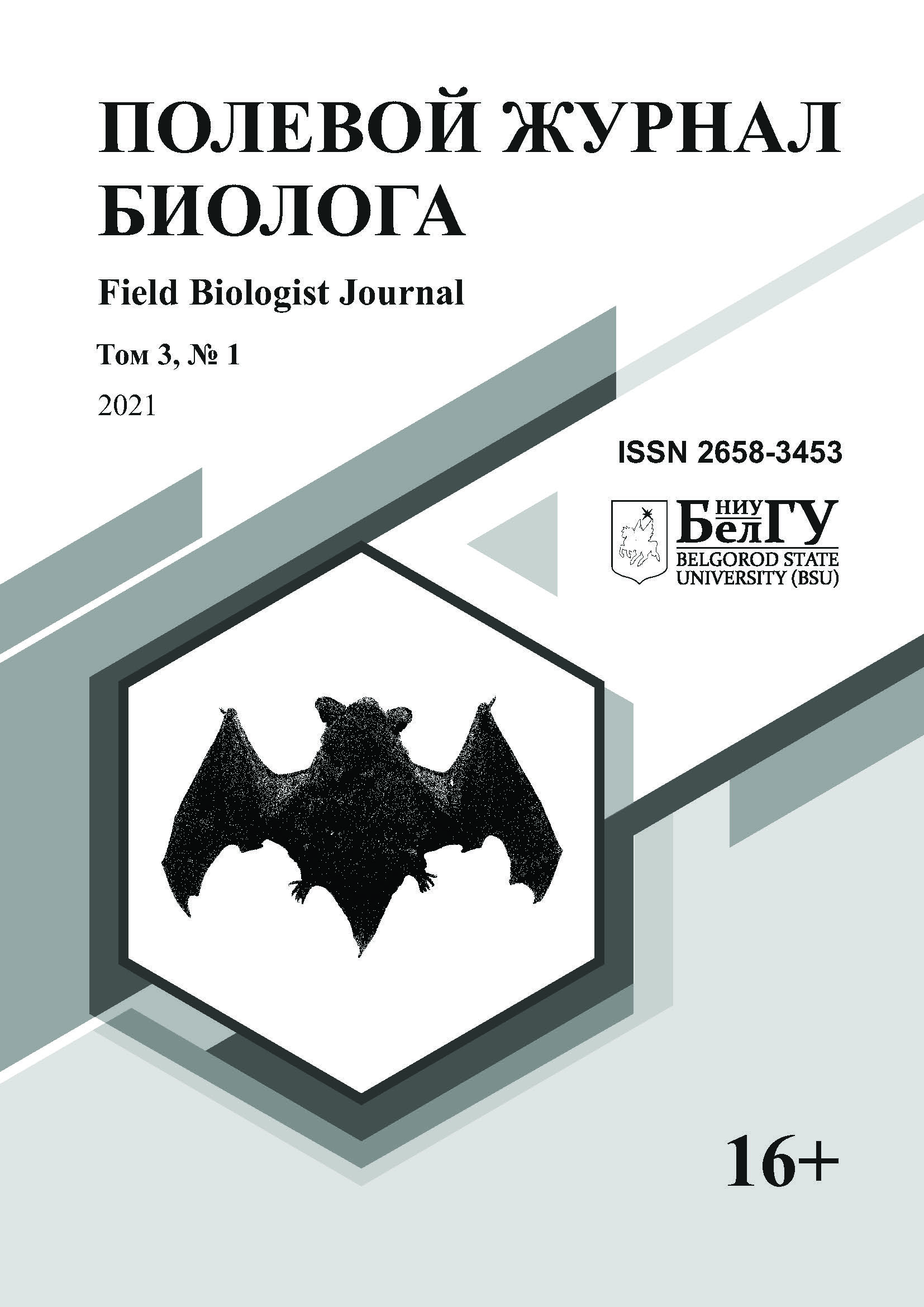The Estimation problem of Indicator Ability of Closed Related Lichen's Species Based on Spectral Analysis
DOI:
https://doi.org/10.52575/2658-3453-2021-3-1-64-73Keywords:
Hypogymnia physodes, Hypogymnia tubulosa, epiphytic lichens, AAS-ICP analysis, macronutrients, trace elements, heavy metals, biomonitoring, Tver regionAbstract
Epiphytic lichen Hypogymnia physodes is widely used in the biomonitoring of environmental condition. The lichen is widely spread and is able to grow in terms of moderate technogenic pollution. However, not all of the systematically related species turn out to have the same stability. Taxonomically close kind of species such as Hypogymnia tubulosa disappears fast as a result of ecosystem's transformation. The aim of the work was to consider the estimation problem of indicator ability of systematically related species and analyse their elemental content with the use of inductively coupled plasma atomic emission spectrometry. The experiment on Hypogymnia indicates that H. tabulosa has a high accumulating ability to calcium, iron, lithium and also heavy metals such as cadmium, lead, aluminium, titan, stibium compared with H. physodes. However, this kind of species appears to be resistant to arsenic. The analysis that includes elemental content and physio-biochemical characterists of closely related lichen's species will enable people to understand the species' resistant mechanisms and vulnerability of the other in the polluted environmental conditions and will become the basis to arrange recommendations of the nature preservation events.
Downloads
References
Бязров Л.Г., Пельгунова Л.А. 2015. Пространственное распределение концентраций ряда элементов в слоевищах лишайника Xanthoria parietina на присоединенной в 2012 году к Москве территории. Проблемы экологического мониторинга и моделирование экосистем, 26 (1): 123–144.
Гимельбрант Д.Е., Кузнецова Е.С. 2009. Лишайники. В кн.: Выявление и обследование биологически ценных лесов на Северо-Западе Европейской части России. Т. 2. СПб.: 93–138.
Голубкина Н.А., Лапченко В.А., Лапченко Е.В., Науменко Т.С., Крайнюк Е.С., Багрикова Н.А. 2019. Фоновые уровни накопления тяжелых металлов, макро- и микроэлементов некоторыми видами лишайников на особо охраняемых природных территориях Южного и Юго-восточного побережья Крыма. Бюллетень ГНБС, 130: 26–35. DOI: 10.25684/NBG.boolt.130.2019.03.
Красная книга Московской области (издание третье, дополненное и переработанное). 2018. (Варлыгина Т.И., Зубакин В.А., Никитский Н.Б., Свиридов А.В., отв. ред.). М.О., ПФ «Верховье», 810 с.
Красная книга Тульской области: растения, грибы (официальное издание). 2010. (Щербаков А.В., ред.). Тула, Гриф и К, 393 с.
Ле Тхи Бич Нгует, Журавлева С.Е., Бондаренко П.В., Трухан Э.М. 2017. Влияние факторов окружающей среды на лишайник Xanthoria parietina (L.) Th. Fr. Спектрометрические методы исследования. Аналитика, 4 (35): 58–62. DOI: 10.22184/2227-572X.2017.35.4.58.62.
Московиченко Д.В., Валеева Э.И. 2011. Содержание тяжелых металлов в лишайниках на севере Западной Сибири. Вестник экологии, лесоведения и ландшафтоведения, 11: 162–172.
Скрипченко Л.С., Вахромеева А.А. 2014. Лихеноиндикация – состояние атмосферного воздуха Гусь-Хрустального района. В кн.: Актуальные проблемы экологии в XXI в. Труды Международной научной конференции (заочной). Владимир, Аркаим: 16–23.
Трифонова Т.А., Салмин А.С. 2019. Использование лишайника Hypogymnia physodes в качестве аккумулятивного биоиндикатора техногенного загрязнения атмосферы. Юг России: экология, развитие, 14 (2): 150–163. DOI: 10.18470/1992-1098-2019-2-150-163.
Справочник промышленных предприятий Тверской области. 2018. Тверь, Министерство промышленности и торговли Тверской области, 374 с.
Gauslaa Y., Yemets O.A., Asplund J., Solhaug K.A. 2016. Carbon based secondary compounds do not provide protection against heavy metal road pollutants in epiphytic macrolichens. Science of the Total Environment, 541: 795–801. DOI: 10.1016/j.scitotenv.2015.09.114.
Meysurova A.F., Khizhnyak S.D., Notov A.A., Pakhomov P.M. 2014. Biomonitoring of sulfur-containing pollutants in an urban atmosphere by FTIR spectroscopy. Journal of Applied Spectroscopy, 81 (4): 654–659. DOI: 10.1007/s10812-014-9985-7.
Meysurova A.F., Notov A.A. 2016а. Physicochemical analysis of indicator lichens as a component of conservation area baseline monitoring. Journal of Applied Spectroscopy, 82 (6): 1005–1012. DOI: 10.1007/s10812-016-0219.
Meysurova A.F., Notov A.A. 2016b. Metal contents in lichens from nature reserves adjacent to urban ecosystems. Journal of Applied Spectroscopy, 83 (5): 832–839. DOI: 10.1007/s10812-016-0371-5.
Meysurova A.F., Notov A.A. 2020. Metal and metalloid contents in lichens from specially rotected conservation areas. Theoretical and Applied Ecology, 3: 58–65. DOI: 10.25750/1995-4301-2020-3-058-065.
Meysurova A.F., Notov A.A., Pungin A.V., Skrypnik L.N. 2020. Complex physico-chemical analysis of lichen Hypogymnia physodes in different phytocenoses. Journal of Applied Spectroscopy, 87 (5): 83–91. DOI: 10.1007/s10812-020-01084-1.
Parzych A., Zduńczyk A., Astel A. 2016. Epiphytic lichens as bioindicators of air pollution by heavy metals in an urban area (Northern Poland). Journal of Elementology, 21 (3): 781–795. DOI: 10.5601/jelem.2016.21.1.861.
Pungin A., Dedkov V. 2017. Assessment of air quality by lichen indication method in the central part of Kaliningrad. Research Journal of Chemistry and Environment, 21 (2): 32–39.
Stojanović G., Zlatanović I., Zrnzević I., Stanković, M., Stankov Jovanović V., Zlatković B. 2018. Hypogymnia tubulosa extracts: chemical profile and biological activities. Natural Product Research, 32 (22): 2735–2739. DOI: 10.1080 / 14786419.2017.1375926.
##article.numberofviews## 382
##submission.share##
Published
How to Cite
Issue
Section
Copyright (c) 2021 Александра Федоровна Мейсурова, Александр Александрович Нотов

This work is licensed under a Creative Commons Attribution 4.0 International License.



